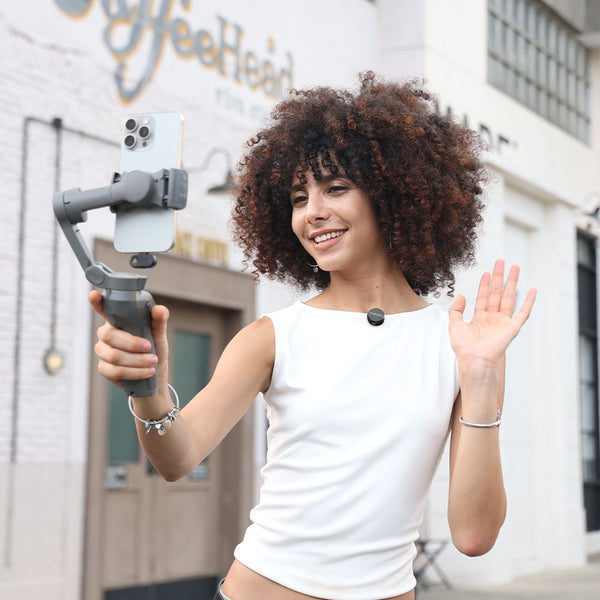Looking for new ways to get fit or lose weight? Why not try the Tabata challenge? Whether you're an instructor or a learner who wants to share and document your fitness journey, you'll need a reliable, lightweight wireless microphone to record your progress. Try these top picks from Maono — the Maono Wave T5 and T1 Mini.
The fitness world is constantly evolving, and few workout styles have gained as much attention as Tabata training. Known for its high intensity and time efficiency, Tabata has become a favorite among trainers, athletes, and everyday fitness enthusiasts looking to burn calories fast. As online fitness communities continue to grow, daily Tabata videos have become an engaging way for creators to inspire others while building their fitness brands.
However, producing professional and motivational workout videos requires more than just strong exercises—it demands clear audio, consistent voice projection, and the right wireless microphone setup. Your viewers should not only see your energy but also feel it through your voice and coaching style. That’s where investing in a quality wireless mic can make all the difference.
However, producing professional and motivational workout videos requires more than just strong exercises—it demands clear audio, consistent voice projection, and the right wireless microphone setup. Your viewers should not only see your energy but also feel it through your voice and coaching style. That’s where investing in a quality wireless mic can make all the difference. Choosing the best wireless microphone for camera or a professional wireless microphone system ensures your voice remains sharp and motivating throughout each workout session.
Before diving into filming tips and audio solutions, let’s briefly explore where Tabata came from and how it became the foundation of so many online fitness routines.

The Origin of Tabata
Tabata training was developed in Japan by Dr. Izumi Tabata and his research team at the National Institute of Fitness and Sports in Tokyo. Originally designed to improve the performance of Olympic speed skaters, the workout follows a 20-second high-intensity exercise followed by 10 seconds of rest, repeated for a total of 4 minutes.
This simple yet powerful formula pushes both aerobic and anaerobic limits, making it a fast and efficient calorie burner. Because of its intensity and short duration, Tabata fits perfectly into the fast-paced lifestyle of today’s fitness community—and it translates seamlessly into short, energetic online videos.
Creating Engaging Daily Tabata Videos to Motivate Your Viewers
In today’s fitness media landscape, consistency and authenticity are key. Posting daily Tabata videos not only motivates your audience to stay active but also helps you establish a reliable fitness presence. To keep viewers engaged, focus on delivering short, high-energy sessions that blend clear instruction, positive energy, and crisp audio.
A strong microphone setup ensures your cues are heard clearly—even over music or background noise—so your audience can follow along without missing a beat. Whether you’re using a mic for recording wireless sessions or a mic for laptop wireless setup for editing and uploads, the right gear will make your voice sound professional and engaging. Let’s explore how to achieve that professional audio standard.
How to Record Daily Tabata Workouts with a Wireless Mic for Clear Audio
Recording Tabata workouts can be challenging because you’re constantly moving, jumping, or changing positions. A wireless microphone is ideal since it eliminates cables and lets you move freely.
When choosing a wireless mic for fitness videos, look for:
-
Stable connection: No dropouts even when you move around.
-
Noise reduction: Filters out background noise from gyms or outdoor spaces.
-
Lightweight design: So it doesn’t interfere with your workout movements.
Start by testing your mic’s position. Place it near your collarbone (if lavalier) or use a headset mic for hands-free clarity. Always do a short test recording to check audio levels before shooting a full workout. The best setup could be a cordless microphone set, which gives you mobility and clean, consistent audio capture during active sessions.
Tips for Shooting Tabata Fitness Videos Indoors or Outdoors
Indoor filming:
-
Ensure good lighting, either natural or soft LED.
-
Use foam mats to reduce echo.
-
Keep the mic away from fans or air vents that may create unwanted noise.
Outdoor filming:
-
Choose quieter environments such as parks or gardens.
-
Use a wind muff or foam cover for your mic to prevent wind distortion.
-
Test your wireless signal to ensure stable transmission between mic and receiver.
Remember, the key is to balance visual appeal and sound quality. Whether you’re filming with the best wireless microphone for camera or smartphone setup, your viewers must hear your instructions clearly, regardless of the location.
Tabata Workout Routines for Fat-Burning and Cardio Endurance
Here are sample daily Tabata routines you can feature in your videos:
-
Full-Body Burn (4 Minutes)
-
Jump squats – 20 seconds
-
Rest – 10 seconds
-
Push-ups – 20 seconds
-
Rest – 10 seconds
-
Mountain climbers – 20 seconds
-
Rest – 10 seconds
-
Burpees – 20 seconds
-
Core Strength Tabata
-
High knees – 20 seconds
-
Rest – 10 seconds
-
Plank jacks – 20 seconds
-
Rest – 10 seconds
-
Sit-ups – 20 seconds
-
Rest – 10 seconds
-
Russian twists – 20 seconds
These routines can be adjusted for beginners or advanced fitness levels. To keep content fresh, vary your exercises daily and highlight calorie burn or endurance goals in your video titles.
How to Keep Your Audience Motivated Through Daily Tabata Challenges
Motivation is what keeps people coming back. Use your wireless mic to speak with energy and emotion, offering encouragement between sets. Phrases like “Push through!” or “You’ve got this!” create a strong connection with your audience.
Additionally, consider launching monthly Tabata challenges or progress tracking systems. Encourage viewers to share their results in the comments or tag you on social media. This sense of community engagement turns your videos into a shared fitness journey.
Voice Projection and Clarity: Using a Wireless Mic While Moving
One of the biggest challenges in recording fitness videos is maintaining vocal clarity while performing intense movements. A good wireless mic allows you to move freely without losing volume or clarity.
Here are some key techniques:
-
Warm up your voice just as you warm up your body.
-
Breathe through the diaphragm for steady airflow.
-
Use your natural tone—avoid shouting. The mic will amplify your voice naturally.
-
Keep consistent mic placement throughout the session.
A lavalier or clip-on mic like the Maono Wave T1 Mini is excellent for dynamic motion, while a Maono Wave T5 offers professional-grade clarity for instructors filming longer or multi-camera sessions. Both mics perform like a professional wireless microphone system, ideal for energetic fitness creators.
Editing and Enhancing Audio for Fitness Video Production
Post-production is where your video truly comes alive. Even if your mic captures good sound, fine-tuning the audio enhances professionalism.
Editing tips:
-
Use software like Adobe Premiere Pro, Final Cut Pro, or DaVinci Resolve.
-
Normalize voice levels to maintain consistent volume.
-
Add upbeat background music, but lower it beneath your voice instructions (around -20dB).
-
Apply light compression and EQ to make your voice sound clean and full.
Whether you’re using a mic for laptop wireless setup for editing or a cordless microphone set for filming, subtle enhancements can transform your recording from amateur to broadcast quality.
Lightweight Wireless Mic Systems for Active Trainers and Instructors
For trainers who film frequently, comfort and durability matter as much as sound quality. Two standout wireless systems for fitness creators are:
1. Maono Wave T5 Wireless Microphone

The Maono Wave T5 is a professional wireless microphone system ideal for high-movement scenarios.
-
Long-range stable transmission
-
Noise reduction for clear outdoor sound
-
Rechargeable, lightweight design
-
Dual-channel receiver for two-person recording
Perfect for instructors filming both solo and collaborative sessions.
2. Maono Wave T1 Mini Wireless Microphone

Compact and affordable, the Maono Wave T1 Mini is perfect for beginners or mobile fitness creators.
Features:
-
Plug-and-play design for smartphones or cameras
-
Excellent voice clarity and wind noise suppression
-
Long battery life for extended recording sessions
Both options deliver reliable, high-quality sound that keeps your viewers engaged and focused on your instructions—making them among the best wireless microphones for camera recording and online fitness creation.
FAQ Section:
1. How can I record clear voice instructions while doing Tabata workouts?
Use a wireless mic with noise-cancelling features and keep it close to your mouth. Test your audio levels before recording.
2. What are the best wireless mics for shooting daily fitness videos?
The Maono Wave T5 and Maono Wave T1 Mini are great options for clear, stable audio during high-intensity movement.
3. How do I attach a wireless mic securely during high-movement exercises?
Clip the lavalier mic to your collar or use tape to secure it under clothing. Avoid loose cables.
4. Can I use budget wireless mics for fitness content without losing audio quality?
Yes, as long as they have noise reduction and stable signal transmission.
5. What’s the ideal camera and mic setup for shooting Tabata at home or the gym?
A tripod-mounted camera or smartphone paired with a wireless lavalier mic works perfectly.
6. How do I reduce background noise when recording Tabata videos with a wireless mic?
Use a wind muff, record in quieter spaces, and apply noise reduction during editing.
7. Should I use a lavalier or headset-style wireless mic for better mobility?
Lavalier mics are discreet and flexible; headset mics are ideal for consistent mic distance.
8. How can I make my voice sound more energetic and motivating on camera?
Smile while speaking, use short motivational cues, and project your voice with confidence.
9. What’s the best way to balance music and voice volume in fitness videos?
Lower music volume to around -20dB and keep voice levels consistent through compression.
10. Are there specific wireless mics designed for sweaty, active workouts?
Yes, look for sweat-resistant models like the Maono Wave series.
11. How effective is Tabata for daily calorie burning and weight loss?
Very effective—short bursts of intensity boost metabolism and continue burning calories post-workout.
12. What’s a good beginner-friendly Tabata routine for daily workouts?
Start with low-impact exercises like squats, modified push-ups, and high knees.
13. How can I keep my audience motivated to follow my daily Tabata sessions?
Encourage progress tracking, celebrate milestones, and maintain energetic communication.
14. How long should each Tabata video be to keep viewers engaged?
Between 5 to 10 minutes, including warm-up and cool-down.
15. What’s the best way to track progress and calorie burn from daily Tabata workouts?
Use fitness trackers or mobile apps that calculate calories based on heart rate and duration.
16. What editing tools work best for combining voice, music, and visuals?
Adobe Premiere Pro, CapCut, or DaVinci Resolve are great for syncing audio and video seamlessly.
17. How can I add motivational voiceovers to my Tabata videos?
Record them separately using a wireless mic in a quiet setting, then overlay during editing.
18. What are creative ideas for naming or branding daily Tabata video series?
Try names like “Tabata 4-Minute Burn,” “Daily Fit Boost,” or “Power Tabata Challenge.”
19. How can I optimize my Tabata videos for YouTube or TikTok fitness audiences?
Use short titles, add timestamps, and highlight calorie burn or specific goals in thumbnails.
20. How important is mic quality for building trust and professionalism in fitness videos?
Extremely important—clear, consistent audio enhances credibility and viewer engagement.
Conclusion
Creating daily Tabata videos is more than just demonstrating workouts—it’s about motivating and connecting with your audience through both movement and sound. A mic for recording wireless or cordless microphone set ensures your energy, tone, and enthusiasm reach your viewers without interference, helping you stand out in a crowded fitness space.
Whether you’re a beginner or a seasoned instructor, tools like the Maono Wave T5 and Wave T1 Mini can elevate your production quality while keeping your sessions active and dynamic. With the right mix of passion, consistency, and professional audio equipment, your daily Tabata videos can truly inspire others to move, sweat, and transform their fitness journey.



